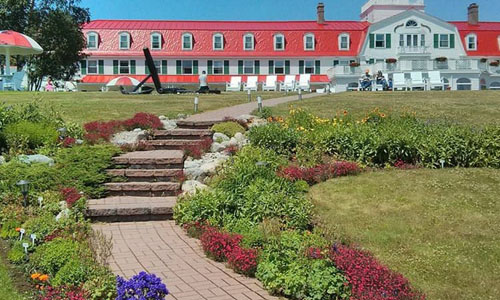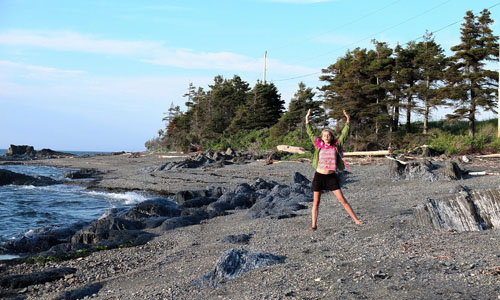
Featured on travelalerts.ca in August 2017
Although I grew up in Montreal, I was never introduced as a child to Quebec’s rich geography, history and beauty that spreads itself like a rich tapestry across the rest of the province.
But I did this summer—and I had the joy of doing this with my own family. Starting in Quebec City, we travelled first along the north shore of the St. Lawrence through the stunning Charlevoix region and then crossed the Saguenay fjord on a short ferry from Baie-Sainte-Catherine up into Tadoussac and then across the river to Trois-Pistoles to explore the south shore.
I had never explored that wide gaping part of the St. Lawrence River northeast of Quebec City that flows into the Gulf of St. Lawrence past New Brunswick and into the Atlantic Ocean—nor had I ever been as far as Tadoussac.
Tadoussac is a town with an annual population of about 850 that swells to about 200,000 visitors over the whalewatching season. Here tourists come from all over the world to catch a glimpse of any of the 13 species that travel these waters. Whalewatching excursions go out by zodiac (or inflatable boats) or larger cruise ships—depending on your tolerance for gusty seas.

Although there are many hotels and inns to choose from in Tadoussac—the most majestic is the lovely Hotel Tadoussac, reminiscent of the early 1900s with its whitewashed walls, red roof and long front lawn with shuffleboard, mini putt and a sweeping view of the sea. Although our room didn’t have air conditioning, we had a cool breeze that swept in across the water, and a heart buffet breakfast in the morning to fortify us for the next phase of our journey.
We then drove to Les Escoumins, about 25 minutes east of Tadoussac and took the car ferry from there for the 1.5-hour trip to Trois-Pistoles on the south shore. Although this ferry was not an official whalewatching expedition, we saw at least as many whales, and as many porpoises during this crossing: a windless sky, the surface of water was like glass, a perfect time to watch the distinctive white fin of the beluga and curved dorsal fin dolphin-like black head of the minke emerge, accompanied by gasps and ooohs, pointed fingers and clicking cameras of its passengers.
This south shore tends to be less known to Anglophone travellers than Charlevoix, which is unfortunate because it has its own distinctive charm—colourful historic villages (with the church at its centre), lighthouses, national parks, farmland and more deciduous forest than on the north shore.
Our our first night there, after arriving in Trois-Pistoles, we drove about an hour east, bypassing Rimouski —one of the largest cities in the area— to arrive at Domaine Valga, a resort—with a large log cabin and a couple of smaller ones— in the small municipality of Saint-Gabriel. Set on a small lake in a forested area teeming with sugar bushes, this area seemed like a francophone version of parts of Eastern Townships where I holidayed as a child.
The difference is that Domaine Valga really is a Quebecois family resort, and the families we joined at the long wooden dinner table for a communal meal that evening were all francophone. (As its co-owner Eric Gagn? tells me, and I can see from the thumb tacks on the map of the world that hangs on the wall indicating the homes of its guests, visitors to Domaine Valga come predominantly from Europe, and particularly from France, often en route to the Gaspésie.
Over vegetable soup with curry chicken and butterscotch pie that evening, our attempt to cross the language divide went something like this.
Turning to the 11-year-old girl next to me, “Qu’as tu fait aujourd’hui?” (What did you do today?)
“J’ai vu un phoque.”
“Fuc?”
“Un phoque.”
“Fuxx?”
This girl is either saying a bad swear word, and has a worse mouth than me, or I’m guessing she seen some kind of an animal. A fox, I wonder?
I ask if there is a French-English dictionary. (This shows my age.) And there is none (which shows the age). But a quick Google search reveals that “phoque” actually means seal in French, which she saw in Bic National Park, a coastal park a short drive a way, which is teeming with seabirds and other wildlife, and opportunities for hiking, biking and kayaking.
The next morning after a hearty pancake breakfast, we head to the Forêt de Maître Corbeau on site, which is a 94-obstacle aerial park with ziplines, rope courses with swinging steps, ladders, a tunnel and even a Tarzan rope where you land in a spiderman-like web (or at least my braver 12-year-old son did…). Then we head to the lake for a swim, and again – we’re off.

For our last night, we make our way to the magical Domaine Floravie in Le Bic area of Rimouski. The Domaine consists of seven tiny perfect houses set far apart from each apart in fields of wild flowers bordering the sea, each house a different colour. Ours is orange. Set on wheels, these teeny tiny houses, some with an upstairs loft, are made all of wood, insulated with hemp, powered by the sun, and heated by propane—with compost toilets and fully functioning kitchens.
And as cleverly constructed and compact as these houses are, their greatest beauty is the view out their windows, which frame the wildness of the sea and the remoteness of this wilderness.
Before bed, we light a fire in the firepit outside our house, and I set out a loaf of bread and pate, cheeses and rillette on our picnic table—supplies that we have picked up from the Boulangerie Folles Farines in the sweet little village of Le Bic about five minutes away.
As the sun sets, we stroll along the sea. My kids spontaneously start to run along the beach, they have a clapping game, we throw pebbles into the sea. (There is no Wifi access here: for a night, I find myself inadvertently but gratefully unplugged.)
The next morning, sadly, we load up the little green wagon with our luggage and then pack up the car, to begin our three-hour drive to the airport in Quebec City. We had only a taste of the south shore. But we’ll be back.
IF YOU GO
Three-hour whalewatching excursions out of Tadoussac can be booked through Croisières AML
Although we missed visiting the Pointe-au-Pere Maritime Historic Site in Rimouski, you can learn about how the Empress of Ireland got shipwrecked, and board Canada’s first submarine open to the public.
Before arriving in Quebec City, visit Kamouraska, a charming riverside town with beautiful piers, shops, museums and kayaking.
For more information on the region, visit Quebec Maritime or Quebec Original for information on the province.